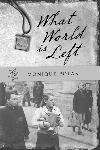A review of What World Is Left by Monique Polak
Published on June 1, 2009

What World Is Left
Monique Polak
Orca Book Publishers
$12.95
paper
215pp
978-1-55143-847-4
In writing
What World is Left, Montrealer Monique Polak drew partially from her mother’s World War II experiences as an inmate at Theresienstadt, a concentration camp in Czechoslovakia. A “model” camp, Theresienstadt was set up as a town – complete with storefronts, a bank, and a governing Council of Elders – that the Nazis could use to convince the international community of their humane treatment of war prisoners. As the novel’s protagonist, Anneke, is quick to learn, however, the town’s thin veneer hides pestilence, hunger, degradation, and despair. Fourteen-year-old Anneke, a Dutch Jew, arrives in Theresienstadt in 1943 with her father – a political cartoonist – her mother, and her younger brother. Now forced to work long hours as a cauldron-scrubber, Anneke finds little solace in a world turned upside down, where each morning could bring notice of one’s transfer to a camp with a more overt agenda of extermination. Even friendship cannot truly comfort, for, as Anneke realizes,
[o]ne person’s agony often means someone else’s gain. And though I am sorry to see others suffer, another part of me – a bigger part – is relieved it isn’t me.
Only her love for her family keeps her going – but when Anneke learns that her father has been using his artistic talents to support the Nazi effort, she comes to see him in a new light. Polak’s story breathes life into a period fading from memory. (Ages 12+) mRb
Andrea Belcham lives in Saint-Lazare, where many of her best neighbours are trees.







0 Comments